Stakeholder Engagement in the Co-Design of Regional Bioeconomy Strategies
Abstract
1. Introduction and Goal Setting
2. Methodology
2.1. Guideline Development
2.1.1. Identification of Key Success Factors for the Establishment of RBHs—Literature Review and Assessment
2.1.2. Validation of Identified Key Factors–Guided Interviews with Five Western European Regions
2.1.3. Final List of Key Success Factors—Synthesis and Categorization
2.2. Guideline Application
2.2.1. Regional Bioeconomy Analysis
2.2.2. Establishment of RBHs
2.2.3. Definition of RBH’s Governance
2.2.4. Stakeholder Involvement—Identification, Analysis, and Engagement
2.2.5. Development of a Common Vision
Preparation Steps Prior to the Workshop–Base Information
Desired Futures—Brainstorming in the Visioning Workshop
Draft a Common Vision—Identifying Common Desired Futures
2.2.6. Regional Bioeconomy Analysis—Strengths, Weaknesses, Opportunities, and Threats (SWOT)
2.2.7. Preparation of Regional Bioeconomy Strategy Document
Definition of the Strategy Development Plan
Determination of Key Aspects for Strategic Interventions
Determination of Priority Areas and Their Corresponding Main Goals
Identification of Available Enabling Mechanisms and Resources
Drafting Strategy Document
Presentation and Feedback to the Strategy
2.2.8. Definition of a Roadmap for the Strategy Implementation
Derivation of Specific Goals within Priority Areas and Corresponding Specific Actions
Establishment of a Time Horizon and Modes of Monitoring for Each of the Planned Actions
Identification of Responsible Institutions for Implementation and Monitoring
Drafting Roadmap Document, Presentation, and Feedback
2.3. Guideline Monitoring
3. Results
3.1. Guideline Development
Key Success Factors for the Creation of Hubs
- Financial support, particularly during the establishment and first years of the RBH, to ensure the strong workload that is required when building a functional organizational structure, together with raising awareness and attracting the key actors that should be involved. EU projects and other public funding are some of the most important sources. For the particular case of clusters, membership fees were mentioned as one of the most important financing sources.
- Key motivated players and the hub manager. The existence of a facilitator(s) was described as crucial, but most importantly their ability to gather other actors. Additionally, the importance of the group that generates a first alliance in the RBH was highlighted, since those are the institutions and individuals that will set everything in motion.
- Involvement of relevant and diverse stakeholders, which is mainly represented by the triple-helix approach and preferably the quadruple-helix approach.
- Institutional capacities represented in available instruments and policies that allow the activities related to the bioeconomy, policy coherence, regulations, and intellectual property rights and that promote interactions, such as the public–private partnerships, which have been found to be a good practice to introduce important bioeconomy innovations and novel business models.
3.2. Guideline Application by CEE Regions
3.2.1. Regional Bioeconomy Analysis
3.2.2. Establishment of RBHs
Establishment of Core Group
Enlarging the Core Group through Stakeholder Identification, Analysis, and Engagement
3.2.3. RBH Governance and Communication
3.2.4. Stakeholder Involvement
3.2.5. Visions of the RBHs and Bioeconomy Regions
“Competitiveness strengthening for the bioeconomy in the Lviv region”
“Mazovia will become a region:
“The RBH Nitra in cooperation with BIOEAST and Bioeconomy Cluster will:
“Closing of the ecological cycle containing water, soil and climate at landscape scale. An effort to build value chains on traditional resources and branches and link them with a new high–value added–sustainable technology. Emphasis on the linkages of value chains of all branches of regional bioeconomy–agriculture, forestry, waste management and non-traditional sources”.
“to become a national leader in the regional bioeconomy development in Hungary by elaborating the regional bioeconomy strategy and through a collaborative approach between the most important relevant parties”.
3.2.6. Regional Bioeconomy Analysis—SWOT
- KF1. Availability and use of resources
- KF2. Infrastructure and industrial factors
- KF3. Research and innovation
- KF4. Market/Economic aspects
- KF5. Transition towards bioeconomy
- KF6. Public and institutional support/Governance/Policy frameworks
- KF7. Funding
- KF8. Social and environmental aspects
3.2.7. Regional Bioeconomy Strategies
3.2.8. Roadmaps
4. Revisiting the Hubs
5. Discussion
6. Conclusions
Supplementary Materials
Author Contributions
Funding
Institutional Review Board Statement
Informed Consent Statement
Data Availability Statement
Conflicts of Interest
References
- McCormick, K.; Kautto, N. The Bioeconomy in Europe: An Overview. Sustainability 2013, 5, 2589–2608. [Google Scholar] [CrossRef]
- Dubois, O.; Gomez San Juan, M. How sustainability is addressed in official bioeconomy strategies at international, national, and regional levels—An overview. Environ. Nat. Resour. Management. Work. Pap. (FAO) 2016. Available online: https://www.fao.org/3/i5998e/i5998e.pdf (accessed on 14 March 2019).
- Bezama, A.; Hildebrandt, J.; Thrän, D. Analyzing the Potential Environmental and Socio-Economic Impacts of Regional Energy Integration Scenarios of a Bio-Based Industrial Network. Sustainability 2022, 14, 15886. [Google Scholar] [CrossRef]
- Wohlfahrt, J.; Ferchaud, F.; Gabrielle, B.; Godard, C.; Kurek, B.; Loyce, C.; Therond, O. Characteristics of bioeconomy systems and sustainability issues at the territorial scale. A review. J. Clean. Prod. 2019, 232, 898–909. [Google Scholar] [CrossRef]
- Peterson, K.; Kaaret, K. Bioeconomy Pathways at National and Regional Levels, (Stockholm Environment Institute) SEI Tallinn. EU. 2020. Available online: https://policycommons.net/artifacts/1358400/bioeconomy-pathways-at-national-and-regional-levels/1971633/ (accessed on 25 August 2020).
- European Commission, Directorate-General for Research and Innovation. A Sustainable Bioeconomy for Europe: Strengthening the Connection between Economy, Society and the Environment: Updated Bioeconomy Strategy; Publications Office of European Union: Luxembourg, 2018; Available online: https://op.europa.eu/en/publication-detail/-/publication/edace3e3-e189-11e8-b690-01aa75ed71a1/ (accessed on 15 March 2019).
- Ministry of Agriculture Czech Republic. Concept of Bioeconomy in the Czech Republic from the Point of View of the Ministry of Agriculture for 2019–2024. (Original title: Koncepce Biohospodářství V České Republice z Pohledu Resortu Ministerstva Zemědělství na Léta 2019–2024). 2019. Available online: https://eagri.cz/public/web/mze/poradenstvi-a-vyzkum/vyzkum-a-vyvoj/koncepce-a-strategie/koncepce-biohospodarstvi-v-ceske.html (accessed on 9 May 2022).
- European Commission, Directorate-General for Research and Innovation. Sustainable Agriculture, Forestry and Fisheries in the Bioeconomy: A Challenge for Europe: 4th SCAR Foresight Exercise; Kovacs, B., Ed.; Publications Office of European Union: Luxembourg, 2015; Available online: https://data.europa.eu/doi/10.2777/179843 (accessed on 11 April 2019).
- European Commission. Communication from the Commission to the European Council and the European Parliament: An Energy Policy for Europe. COM (2007) 1 Final. 2007. Available online: https://eur-lex.europa.eu/legal-content/EN/TXT/PDF/?uri=CELEX:52007DC0001&from=EN (accessed on 14 March 2019).
- Biofuture Platform. Vision Statement: Scaling-up the Low Carbon Bioeconomy: An Urgent and Vital Challenge. 2017. Available online: https://gbs2020.net/wp-content/uploads/2021/10/Biofuture-Platform-Vision-Statement-Final_1_.pdf (accessed on 21 June 2022).
- Ingrao, C.; Bacenetti, J.; Bezama, A.; Blok, V.; Goglio, P.; Koukios, E.G.; Lindner, M.; Nemecek, T.; Siracusa, V.; Zabaniotou, A.; et al. The potential roles of bio-economy in the transition to equitable, sustainable, post fossil-carbon societies: Findings from this virtual special issue. J. Clean. Prod. 2018, 204, 471–488. [Google Scholar] [CrossRef]
- Priefer, C.; Jörissen, J.; Frör, O. Pathways to Shape the Bioeconomy. Resources 2017, 6, 10. [Google Scholar] [CrossRef]
- Elbersen, B.; Houtkamp, J.; Coninx, I.; van den Oever, M.; Hatvani, N.; Koos, A.; Mateffy, K.; Kulmány, I.; Vásáry, V. An Overview of Suitable Regional Policies to Support Bio-Based Business Models (Deliverable 4.2). 2020. Available online: https://library.wur.nl/WebQuery/wurpubs/fulltext/524319 (accessed on 21 June 2022).
- OECD. The Bioeconomy to 2030: Designing a Policy Agenda; Organisation for Economic Cooperation and Development—OECD Observer: Pairs, France, 2009; ISBN 978-92-64-03853-0. [Google Scholar]
- European Commission, Directorate-General for Research and Innovation. Innovating for Sustainable Growth: A Bioeconomy for Europe. 2012. Available online: https://data.europa.eu/doi/10.2777/6462 (accessed on 22 January 2019).
- German Bioeconomy Council. Bioeconomy Policy (Part III): Update Report of National Strategies around the World. 2018. Available online: https://www.biooekonomierat.de/media/pdf/archiv/international-bioeconomy-policy-part-III.pdf?m=1637834907& (accessed on 23 May 2019).
- BIOEAST. Vision Paper. BIOEAST-Central and Eastern European Initiative for Knowledge-Based Agriculture, Aquaculture and Forestry in the Bioeconomy. 2018. Available online: https://bioeast.eu/download/bioeast_vision_paper_23022018/ (accessed on 21 January 2019).
- Meyer, R. Bioeconomy strategies: Contexts, visions, guiding implementation principles and resulting debates. Sustainability 2017, 9, 1031. [Google Scholar] [CrossRef]
- De Besi, M.; McCormick, K. Towards a bioeconomy in Europe: National, Regional and Industrial Strategies. Sustainability 2015, 7, 10461–10478. [Google Scholar] [CrossRef]
- Charles, D.; Davies, S.; Miller, S.; Clement, K.; Overbeek, G.; Hoes, A.C.; Hasenheit, M.; Kiresiwa, Z.; Kah, S.; Bianchini, C. Case Studies of Regional Bioeconomy Strategies across Europe. 2016. Available online: http://eprints.lincoln.ac.uk/id/eprint/23999/ (accessed on 3 April 2019).
- Overbeek, G.; de Bakker, E.; Beekman, V.; Davies, S.; Kiresiewa, Z.; Delbrück, S.; Ribeiro, B.; Stoyanov, M.; Vale, M. Review of Bioeconomy Strategies at Regional and National Levels. (Deliverable 2.3) BioSTEP. 2016. Available online: https://bio-step.eu/fileadmin/BioSTEP/Bio_documents/BioSTEP_D2.3_Review_of_strategies.pdf (accessed on 9 May 2019).
- Haarich, S.; Kirchmayr-Novak, S.; Sanchez Lopez, J.; Borzacchiello, M.T.; Avraamides, M. Regional Bioeconomy Strategies in the EU. European Commission, Joint Research Centre (JRC) [Dataset]. 2022. Available online: https://data.europa.eu/89h/a89482ff-83af-4c82-96ef-39b0a59eb345 (accessed on 17 November 2022).
- Bioökonomierat. Data, Facts, Responsibilities: Where Does the Bioeconomy Stand in the Countries? A Stocktaking of the III Bioeconomy Council in Cooperation with Actors at the State Level. (Original Title: Daten, Fakten, Zuständigkeiten: Wo Steht Die Bioökonomie in den Ländern? Eine Bestandsaufnahme des III. Bioökonomierats in Zusammenarbeit mit Akteur:innen auf Länderebene). 2022. Available online: https://www.biooekonomierat.de/publikationen/hintergrundpapiere/2022/biooekonomie-in-den-laendern.php (accessed on 8 February 2023).
- Committee of the Regions. OPINION: The Local and Regional Dimension of Bioeconomy and the Role of Regions and Cities. SEDEC-VI-022, Brussels. 2017. Available online: https://pes.cor.europa.eu/local-and-regional-dimension-bioeconomy-and-role-regions-and-cities (accessed on 12 April 2019).
- European Network for Rural Development (ENRD). Supporting Sustainable Rural Bioeconomy Value Chains: Briefing for the Second Meeting of ENRD Thematic Group on the Bioeconomy. 2018. Available online: https://enrd.ec.europa.eu/sites/default/files/tg2_bioeconomy_draft-briefing.pdf (accessed on 15 April 2019).
- Kircher, M.; Breves, R.; Taden, A.; Herzberg, D. How to capture the bioeconomy’s industrial and regional potential through professional cluster management. N. Biotechnol. 2018, 40, 119–128. [Google Scholar] [CrossRef]
- Bezama, A.; Ingrao, C.; O’Keeffe, S.; Thrän, D. Resources, collaborators, and neighbors: The three-pronged challenge in the implementation of bioeconomy regions. Sustainability 2019, 11, 7235. [Google Scholar] [CrossRef]
- Davies, S.; Ribeiro, B. Good Practice Guidelines for Stakeholder and Citizen Participation in Bioeconomy Strategies: Deliverable 2.3 BioSTEP. 2016. Available online: https://www.bio-step.eu/fileadmin/BioSTEP/Bio_documents/BioSTEP_D3.3_Good_practice_guidelines.pdf (accessed on 11 April 2019).
- Devaney, L.; Henchion, M. Consensus, caveats and conditions: International learnings for bioeconomy development. J. Clean. Prod. 2018, 174, 1400–1411. [Google Scholar] [CrossRef]
- Cortright, J. Making Sense of Clusters: Regional Competitiveness and Economic Development. 2006. Available online: https://www.brookings.edu/research/making-sense-of-clusters-regional-competitiveness-and-economic-development/ (accessed on 11 April 2019).
- Porter, M.E. Location, Competition, and Economic Development: Local Clusters in a Global Economy. Econ. Dev. Q. 2000, 14, 15–34. [Google Scholar] [CrossRef]
- Feldman, M.P. Location and Innovation: The New Economic Geography of Innovation, Spillovers, and Agglomeration; Oxford University Press: Oxford, UK, 2000; ISBN 0198234104. [Google Scholar]
- D’Adamo, I.; Sassanelli, C. Biomethane community: A research agenda towards sustainability. Sustainability 2022, 14, 4735. [Google Scholar] [CrossRef]
- Romero-Perdomo, F.; González-Curbelo, M.Á. Integrating Multi-Criteria Techniques in Life-Cycle Tools for the Circular Bioeconomy Transition of Agri-Food Waste Biomass: A Systematic Review. Sustainability 2023, 15, 5026. [Google Scholar] [CrossRef]
- Kiresiewa, Z.; Duin, L.; Gerdes, H. 1.1. Limitations of Stakeholder and Public Engagement in Bioeconomy Strategy Development Processes. In Zukünfte Nachhaltiger Bioökonomie: Kommunikation und Partizipation Neuen Wirtschaftsformen; Transcript Verlag: Bielefeld, Germany, 2022; pp. 33–44. [Google Scholar] [CrossRef]
- Philp, J.; Winickoff, D.E. Clusters in industrial biotechnology and bioeconomy: The roles of the public sector. Trends Biotechnol. 2017, 35, 682–686. [Google Scholar] [CrossRef]
- Hatvani, N.; van den Oever, M.J.A.; Mateffy, K.; Koos, A. Bio-based Business Models: Specific and general learnings from recent good practice cases in different business sectors. Bio-Based Appl. Econ. 2022, 11, 185–205. [Google Scholar] [CrossRef]
- Szarka, N.; Kittler, R. Bioeconomy Networks in Europe; The Bioeconomy System; Thrän, D., Moesenfechtel, U., Eds.; Springer: Berlin/Heidelberg, Germany; Leipzig, Germany, 2022; ISBN 978-3-662-64415-7. [Google Scholar]
- Sanz-Hernandez, A.; Sanagustín-Fons, M.V.; López-Rodríguez, M.E. A transition to an innovative and inclusive bioeconomy in Aragon, Spain. Environ. Innov. Soc. Transit. 2019, 33, 301–316. [Google Scholar] [CrossRef]
- Bringezu, S.; Banse, M.; Ahmann, L.; Bezama, N.A.; Billig, E.; Bischof, R.; Blanke, C.; Brosowski, A.; Brüning, S.; Borchers, M. Pilot Report on the Monitoring of the German Bioeconomy. 2021. Available online: https://kobra.uni-kassel.de/handle/123456789/13534 (accessed on 17 March 2022).
- Thrän, D.; Moesenfechtel, U. The Bioeconomy System; Springer: Berlin/Heidelberg, Germany, 2022; ISBN 978-3-662-64414-0. [Google Scholar]
- POWER4BIO-Empowering Regional Stakeholders for Realising the Full Potential of European Bioeconomy: H2020 Project-Grant Agreement No 818351. Available online: https://power4bio.eu/ (accessed on 3 February 2023).
- Karachaliou, E.; Delioglanis, I. Cooperation Challenges among Consumers, Brand Owners and Biobased Industry: D2.1-Biobridges. 2019. Available online: https://ec.europa.eu/research/participants/documents/downloadPublic?documentIds=080166e5c1fdbaf4&appId=PPGMS (accessed on 8 April 2019).
- Lopolito, A.; Prosperi, M.; Sisto, R.; de Meo, E. Translating local stakeholders’ perception in rural development strategies under uncertainty conditions: An application to the case of the bio-based economy in the area of Foggia (South Italy). J. Rural Stud. 2015, 37, 61–74. [Google Scholar] [CrossRef]
- Barnabé, S.; Jacques, J.-P.; Villemont, C.; Lemire, P.-O.; Adjallé, K.; Bourdeau, N.; Rezazgui, O.; Audy, J.-F.; Labelle, F.; Mangin, P. How Industries and Cities Are Seizing the Opportunity of the Bioeconomy to Enable Prosperous and Sustainable Regions: Cases from Quebec. Ind. Biotechnol. 2019, 15, 113–117. [Google Scholar] [CrossRef]
- Albrecht, M. (Re-)producing bioassemblages: Positionalities of regional bioeconomy development in Finland. Local Environ. 2019, 24, 342–357. [Google Scholar] [CrossRef]
- Ingstrup, M.B. The role of cluster facilitators. Int. J. Glob. Small Bus. 2010, 4, 25–40. [Google Scholar] [CrossRef]
- SCAR BSW; BBI JU. Workshop Report: Lessons Learned and Recommendations for Developing Clusters in the Bioeconomy: Advancing the Creation of Regional Bioeconomy Clusters in Europe. 2019. Available online: https://www.scar-swg-sbgb.eu/lw_resource/datapool/_items/item_40/cluster_workshop_final_report.pdf (accessed on 11 April 2019).
- Burger, P.; Brašková, M.; Duľová Spišáková, E.; Klasová, S.; Korobaničová, I.; Kováč, V.; Pálfyová, J. Cluster Promotion and Management: The Current Global Situation; ASERS Publishing: Craiova, Romania, 2015; ISBN 978-606-8689-15-9. [Google Scholar]
- Gretzinger, S.; Royer, S. Relational resources in value adding webs: The case of a Southern Danish firm cluster. Eur. Manag. J. 2014, 32, 117–131. [Google Scholar] [CrossRef]
- Klofsten, M.; Bienkowska, D.; Laur, I.; Sölvell, I. Success Factors in Cluster Initiative Management. Ind. High. Educ. 2015, 29, 65–77. [Google Scholar] [CrossRef]
- Ffowcs-Williams, I. Regional Cluster Initiative in the Pacific: Cluster Development & Management Manual. 2014. Available online: https://irp-cdn.multiscreensite.com/bcb8bbe3/files/uploaded/doc_690.pdf (accessed on 15 April 2019).
- Boja, C. Clusters models, factors and characteristics. Int. J. Econ. Pract. Theor. 2011, 1, 34–43. Available online: https://papers.ssrn.com/sol3/papers.cfm?abstract_id=1987198 (accessed on 23 April 2019).
- Lundequist, P.; Power, D. Putting Porter into practice? Practices of regional cluster building: Evidence from Sweden. Eur. Plan. Stud. 2002, 10, 685–704. [Google Scholar] [CrossRef]
- European Cluster Observatory. Regional Ecosystem Scoreboard Updated: Methodology Report. 2017. Available online: https://ec.europa.eu/docsroom/documents/24983 (accessed on 22 April 2019).
- Trippl, M.; Grillitsch, M.; Isaksen, A.; Sinozic, T. Perspectives on cluster evolution: Critical review and future research issues. Eur. Plan. Stud. 2015, 23, 2028–2044. [Google Scholar] [CrossRef]
- RDI2CluB Consortium. Benchmarking Report: Triple-Helix Co-Operation in Biobased Delta. Benchmarking Visit to Biobased Delta Bioeconomy Cluster in The Netherlands. 18–20 April 2018. Available online: https://www.jamk.fi/sites/default/files/2021-11/report_biobaseddelta_benchmarkingrdi2club_final_revised-ws.pdf (accessed on 15 April 2019).
- State Statistics Service of Ukraine. Public Database. Available online: https://www.ukrstat.gov.ua/ (accessed on 27 February 2023).
- State Forest Resources Agency of Ukraine. Public Database. Available online: https://forest.gov.ua/en/agentstvo/about-state-forest-resources-agency-ukraine (accessed on 27 February 2023).
- Central Statistical Office for Mazovia Region. Statistical Local Data Bank. Available online: https://bdl.stat.gov.pl/bdl/start (accessed on 23 February 2023).
- Statistical Office of the SR. Nitriansky Kraj in Figures 2019. Available online: www.statistics.sk (accessed on 23 February 2023).
- Štatistický Úrad Slovenskej Republiky. STATdat. Public Database. Available online: http://statdat.statistics.sk (accessed on 23 February 2023).
- Statistical Yearbook of South Bohemian Region 2017. Table 12-1 Selected Data on Forestry in the South Bohemia Region. 2016. Available online: https://www.czso.cz/documents/10180/45990431/330105171201.xlsx/b038f365-452e-4d1a-9ed5-7b377cc2f1be?version=1.1 (accessed on 28 February 2023).
- Statistical Yearbook of South Bohemian Region 2017. Utilised Agricultural Land (Hectares). Table 11-1. Selected Data on Agriculture in the 2016. Available online: https://www.czso.cz/documents/10180/45990431/330105171101.xlsx/1428fac8-ef13-4f52-ae87-bfb78c2f66ff?version=1.3 (accessed on 28 February 2023).
- Czech Statistical Office (CZSO). Public Database. Available online: https://www.czso.cz/csu/xc/charakteristika_kraje (accessed on 28 February 2023).
- Regional Administration of the Czech Statistical Office in České Budějovice. South Bohemia Region from the Perspective of Regional Accounts in 2017. Available online: https://www.czso.cz/documents/11256/162338488/tab_makroekJHC_2019.xlsx/ (accessed on 28 February 2023).
- SEA Information System. Territorial Energy Concept of the South Bohemian Region for 2018–2043: Assessment of Concepts. 2020. Available online: https://portal.cenia.cz/eiasea/detail/SEA_JHC024K (accessed on 28 February 2023).
- Hungarian Central Statistical Office. STADAT Table No. 8.1.2.1. Area, Settlements Density, Population Density. Available online: https://www.ksh.hu/stadat_files/fol/en/fol0006.html (accessed on 28 February 2023).
- Hungarian Central Statistical Office. STADAT Table No. 22.1.2.1. Resident Population by Sex, County and Region. Available online: https://www.ksh.hu/stadat_files/nep/en/nep0034.html (accessed on 28 February 2023).
- Hungarian Central Statistical Office. STADAT Table No. 21.1.2.1. Gross Domestic Product (GDP) by County and Region. Available online: https://www.ksh.hu/stadat_files/gdp/en/gdp0077.html (accessed on 28 February 2023).
- Hungarian Central Statistical Office. STADAT Table No. 15.1.2.15. Stocked Forest Area, Growing Stock, Logging, Afforestation and Forest Regeneration. Available online: https://www.ksh.hu/stadat_files/kor/en/kor0059.html (accessed on 28 February 2023).
- Hungarian Central Statistical Office. STADAT Table no. 15.1.1.29. The Volume of Each Type of Waste by Method of Treatment. Available online: https://www.ksh.hu/stadat_files/kor/en/kor0029.html (accessed on 28 February 2023).
- The Cabinet of Ministers of Ukraine. Action National Plan in Reference to Renewable Energy for the Period up to 2020. 2014. Available online: https://zakon.rada.gov.ua/laws/show/902-2014-%D1%80#n135 (accessed on 27 February 2023).
- Ministry of Energy and Coal Industry. Energy Strategy of Ukraine for the Period up to 2035 “Safety, Energy Efficiency, Competitiveness”. 2017. Available online: https://zakon.rada.gov.ua/laws/show/605-2017-%D1%80#Text (accessed on 27 February 2023).
- Lviv Regional State Administration. Strategy of the Lviv Region Development for the Period up to 2020. 2016. Available online: https://old.loda.gov.ua/upload/users_files/11/upload/Strategiya-rozvYtku-L_vivs_koi-oblasti-na-period-do-2020-roku1.pdf (accessed on 27 February 2023).
- Municipal Government of the Mazowieckie Voivodship. Development Strategy of the Mazowieckie Voivodship 2030. Mazovia as on Innovative Region (Strategia Rozwoju Województwa Mazowieckiego do 2030 Roku. Innowacyjne Mazowsze). 2014. Available online: http://www.mazowieckieobserwatorium.pl/media/_mik/files/2427/srwm-skr-pol.pdf (accessed on 23 February 2023).
- Minister of Agriculture and Rural Development. Rural Development Program 2014–2020 (RDP 2014–2020), Poland. Available online: https://www.gov.pl/web/rolnictwo/-program-rozwoju-obszarow-wiejskich-2014-2020-prow-2014-2020 (accessed on 23 February 2023).
- Mazowieckie Voivodeship. Waste Management Plan of the Mazowieckie Voivodeshipe. Resolution 3/19 of the Mazovian Regional Assembly of 22 January 2019. 2019. Available online: https://bip.mazovia.pl/pl/bip/sejmik/uchwaly-sejmiku/rejestr-uchwal-sejmiku/nr-319-z-dn-2019-01-22.html (accessed on 23 February 2023).
- Ministry of Agriculture and Rural Development of the Slovak Republic. RIS3 Strategy (Slovakia)–Domain Healthy Food and Healthy Environment. 2013. Available online: https://bioeconomy.sk/wp-content/uploads/2017/11/Zdrave-potraviny_a_zivotne-prostredie_2_.pdf (accessed on 24 February 2023).
- Ministry of Agriculture and Rural Development of Slovakia. Slovakia-Rural Development Programme (National). 2018. Available online: https://www.apa.sk/index.php?start&navID=496 (accessed on 24 February 2023).
- Nitra Self-Governing Region. Programme of Economic and Social Development of the Nitra Region (2016–2022). Available online: https://www.unsk.sk/ (accessed on 24 February 2023).
- Ministry of Industry and Trade of Czech Republic. National Action Plan for Renewable Energy (Národní Akční Plán pro Obnovitelné Zdroje Energie). 2016. Available online: https://www.mpo.cz/cz/energetika/elektroenergetika/obnovitelne-zdroje/narodni-akcni-plan-pro-obnovitelne-zdroje-energie--169894/ (accessed on 28 February 2023).
- Ministry of Agriculture. National Action Plan for Biomass (Akční Plán pro Biomasu v ČR 2012–2020). 2012. Available online: https://www.databaze-strategie.cz/cz/mze/strategie/akcni-plan-pro-biomasu-v-cr-2012-2020 (accessed on 28 February 2023).
- Ministry of Environment of the Czech Republic. State Energy Concept of the Czech Republic. 2015. Available online: https://www.mpo.cz/dokument158059.html (accessed on 28 February 2023).
- Ministry of the Environment. Strategic Framework-Sustainable Development of the Czech Republic. 2010. Available online: https://www.vlada.cz/assets/ppov/udrzitelny-rozvoj/Strategicky_ramec_udrzitelneho_rozvoje.pdf (accessed on 28 February 2023).
- Smart Accelerator of the South Bohemian Region. Regional Annex to the National RIS 3: Update No. 1 for 2018–2022. 2018. Available online: https://www.kraj-jihocesky.cz/sites/default/files/inline-files/2020/15496299019386-132-aktualizace-ris3-jck-final.pdf (accessed on 28 February 2023).
- South Bohemian Region. Development Program of the South Bohemian Region 2014–2020. 2014. Available online: https://www.kraj-jihocesky.cz/sites/default/files/inline-files/PRK%202014-2020_strategick%C3%A1%20%C4%8D%C3%A1st.pdf (accessed on 28 February 2023).
- Ministry of National Development. Republic of Hungary-National Renewable Energy Action Plan/2010–2022. 2009. Available online: https://2010-2014.kormany.hu/download/5/b9/30000/Printable%20version_RENEWABLE%20ENERGY_REPUBLIC%20OF%20HUNGARY%20NATIONAL%20RENEWABLE%20ENERGY%20ACTION%20PLAN%202010_2020.pdf (accessed on 23 February 2023).
- Timur, S.; Getz, D. A network perspective on managing stakeholders for sustainable urban tourism. Int. J. Contemp. Hosp. Mngt. 2008, 20, 445–461. [Google Scholar] [CrossRef]
- García Laverde, L.; Szarka, N.; Schmidt-Baum, T.; Shmyhelska, L.; Hatvani, N.; Mateffy, K.; Kiyko, O.; Cudlínová, E.; Moravčíková, D.; Luks, A. Summaries of Five New Regional Bioeconomy Strategies (Deliverable 5.3). 2020. Available online: https://power4bio.eu/wp-content/uploads/2020/11/POWER4BIO_D5.3_Summaries-of-5-new-regional-bioeconomy-strategies_20201111_FV.pdf (accessed on 21 June 2022).
- García Laverde, L.; Kalai, K.; Mateffy, K.; Kiyko, O.; Luks, A.; Cudlínová, E.; Moravčíková, D. Summaries of Five New Implementation Plans (Deliverable 5.4). Available online: https://power4bio.eu/wp-content/uploads/2021/03/D5.4-Summaries-of-5-new-regional-bioeconomy-strategies.pdf (accessed on 15 August 2022).
- European Network for Rural Development (ENRD). European Rural Bioeconomy: Policy and Tools: Conclusions from the ENRD Thematic Group on ‘Mainstreaming the Bioeconomy’—Part 1. 2018. Available online: https://ec.europa.eu/enrd/publications_en.html (accessed on 14 November 2022).
- Dieken, S.; Dallendörfer, M.; Henseleit, M.; Siekmann, F.; Venghaus, S. The multitudes of bioeconomies: A systematic review of stakeholders’ bioeconomy perceptions. Sustain. Prod. Consum. 2021, 27, 1703–1717. [Google Scholar] [CrossRef]
- Zeug, W.; Bezama, A.; Moesenfechtel, U.; Jähkel, A.; Thrän, D. Stakeholders’ interests and perceptions of bioeconomy monitoring using a sustainable development goal framework. Sustainability 2019, 11, 1511. [Google Scholar] [CrossRef]
- Lühmann, M. Whose European bioeconomy? Relations of forces in the shaping of an updated EU bioeconomy strategy. Environ. Dev. 2020, 35, 100547. [Google Scholar] [CrossRef]
- Gerdes, H.; Zoritza, K.; Beekman, V.; Bianchini, C.; Davies, S.; Griestop, L.; Janssen, R.; Khawaja, C.; Mannhardt, B.; Mazzariol, F.; et al. Engaging Stakeholders and Citizens in the Bioeconomy: Lessons Learned from BioSTEP and Recommendations for Future Research: Deliverable 4.2-BioSTEP. 2018. Available online: https://www.ecologic.eu/sites/default/files/publication/2018/2801-biostep_d4.2_lessons_learned_from_biostep.pdf (accessed on 14 November 2022).

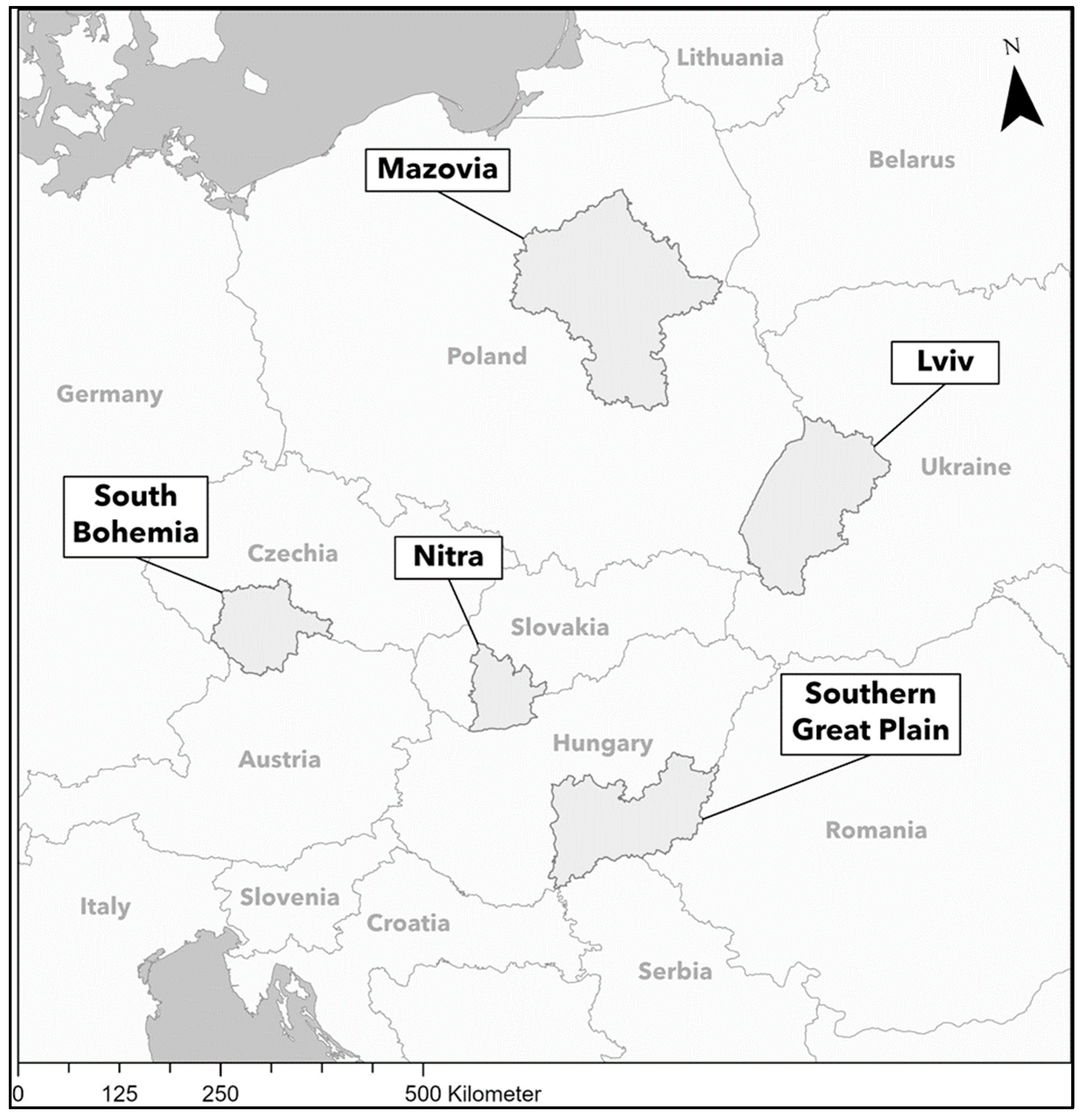

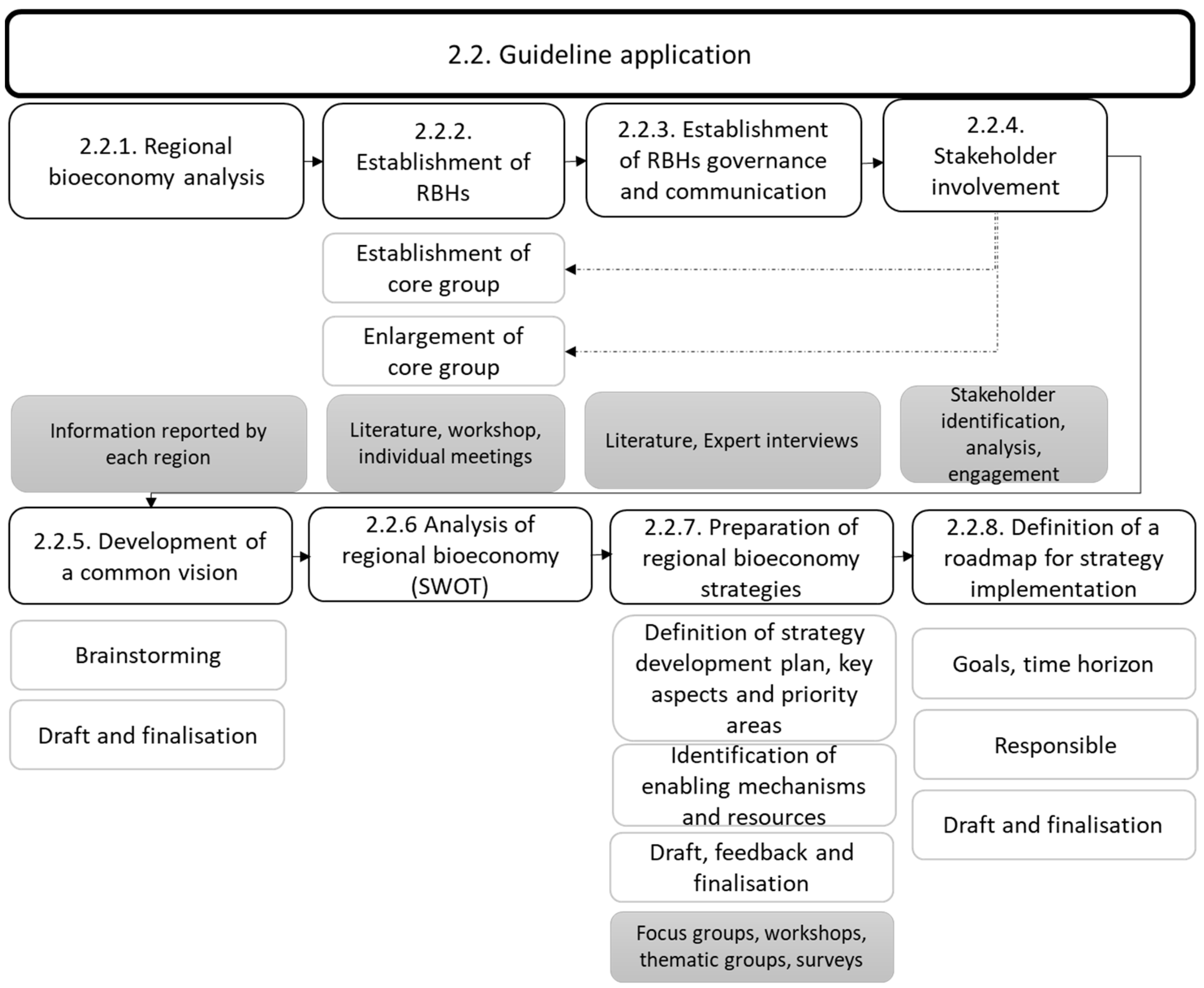
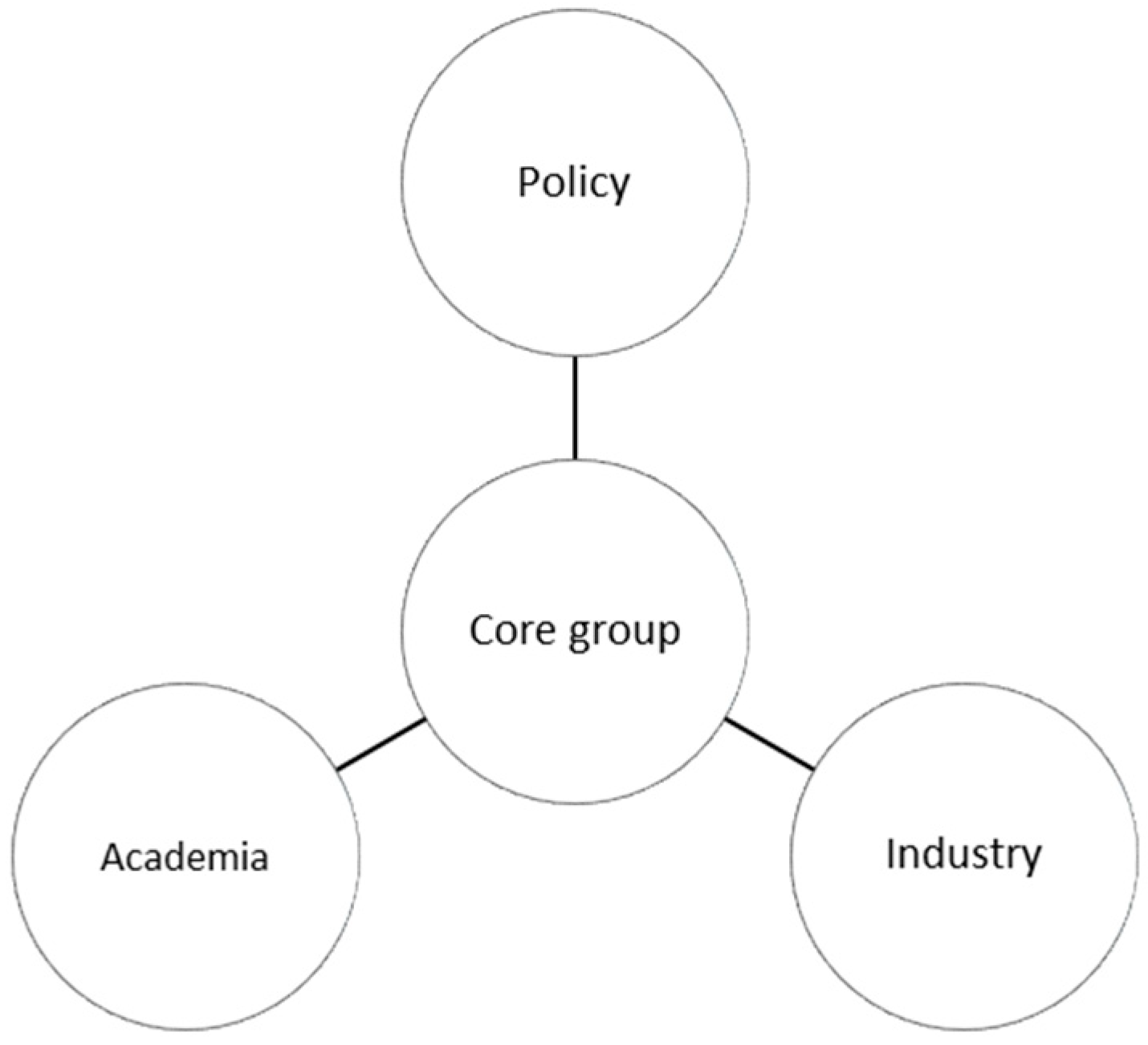
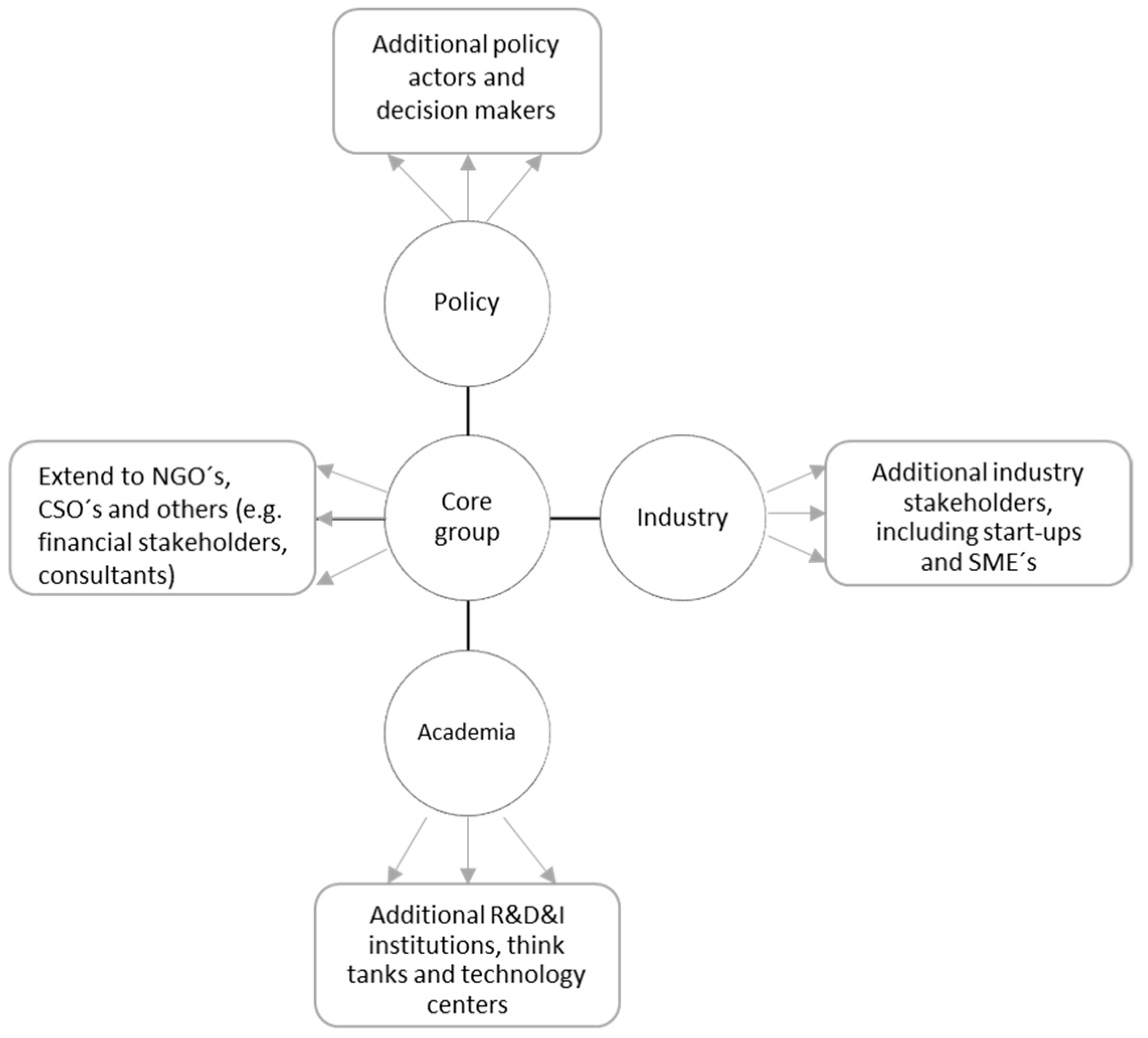

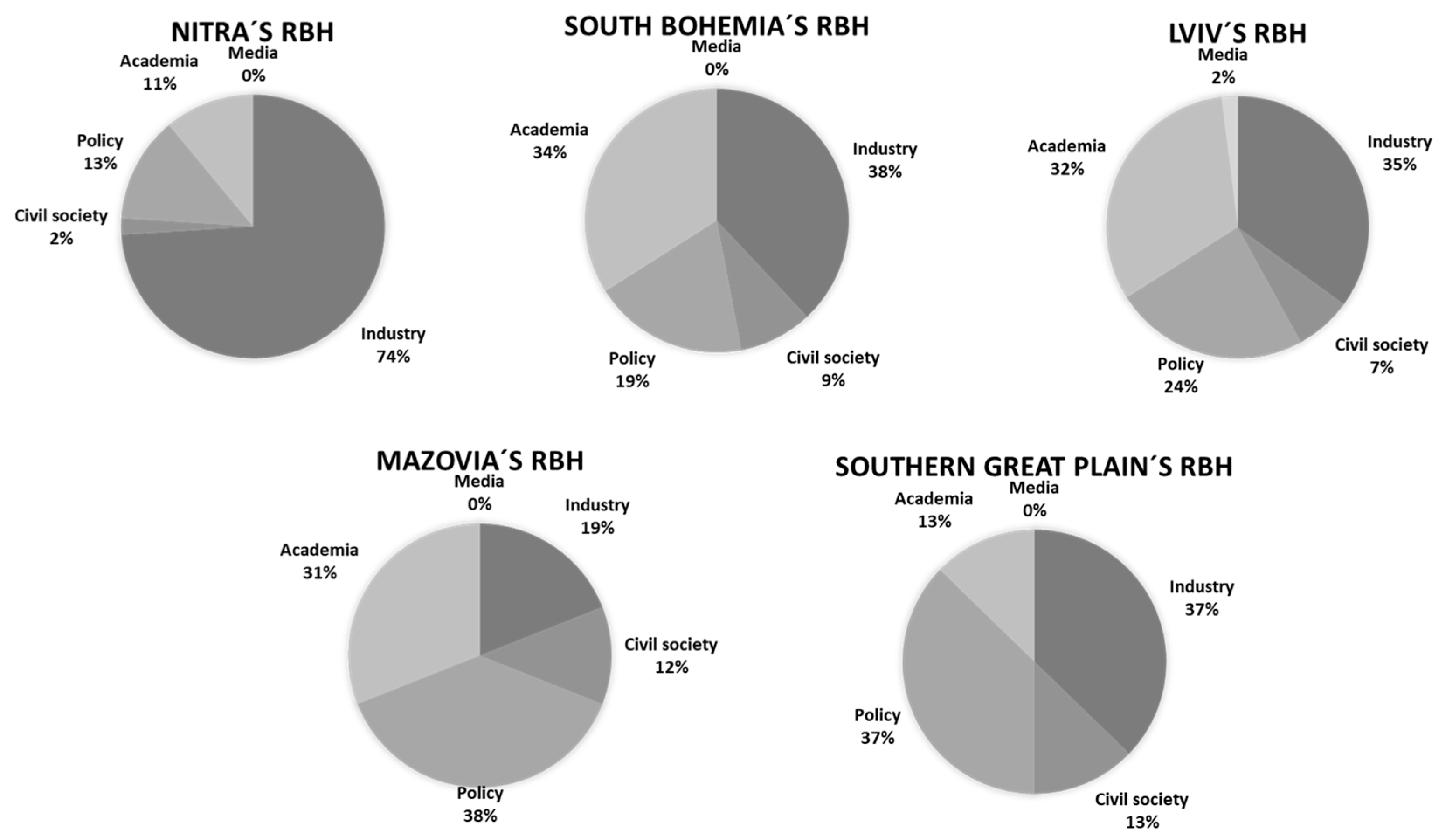
| Category | Success Factors for RBH Establishment |
|---|---|
| Hub definition and organization |
|
| Involved stakeholders |
|
| Management |
|
| Activities, services, benefits |
|
| Financial support/resources |
|
| External factors-regional ecosystem |
|
| Region | Bioeconomy Potential | Bioeconomy Definition | Related Strategies |
|---|---|---|---|
| Lviv | Forest and wood sector Agro-food sector | No explicitly defined for the region. Understood as defined in the EU bioeconomy strategy (2018). | Action National Plan in reference to Renewable Energy for the period up to 2020 [73] Energy Strategy of Ukraine for the period up to 2035 "Safety, Energy Efficiency, Competitiveness” [74] Strategy of the Lviv region’s development for the period up to 2020 [75] |
| Mazovia | Agriculture and forestry industry Sustainable energy sector Chemical industry Waste management | Not a common definition adopted in the region. | Development Strategy of Mazovieckie Voivodeship 2030 [76] Rural Development Programme for 2014–2020 [77] and Waste Management Plan of the Mazowieckie Voivodeship [78]. |
| Nitra | Agro-food and feed Agricultural and forest residues Energy crops Municipal waste (separation, composting) | The areas related to bioeconomy have been outlined by the Ministry of Agriculture and Rural Development of the SR and include agriculture, forestry, fisheries, food and feed production, renewable energy, the chemistry sector, and biotechnology. | RIS3 strategy (Slovakia)–domain Healthy food and healthy environment [79] National Action Plan for Energy from Renewable Energy Sources. Rural Development Programme of the SR (2014–2020) [80] Programme of Economic and Social Development of the Nitra region (2016–2022) [81] Long-term Regional Research Strategy Regional energy concept for the use of agricultural and forestry biomass (Nitra) |
| South Bohemia | Forest residues Feedstock from forest-based industries, Agricultural residues Bioenergy (Biogas) Biotechnology | Not a common definition adopted in the region. | National Action Plan for Renewable Energy [82] National Action Plan for Biomass [83] State Energy Concept of the Czech Republic [84] Concept of Sustainable Development (Sustainable Development) [85] Regional Appendix to National Research and Innovation Strategy (RIS3) [86] Development program of the South Bohemian Region 2014–2020 [87] |
| Southern Great Plain | Agriculture residues Forest residues Energy crops Industry by-products | Not a common definition adopted in the region. | Hungarian Renewable Energy Utilization Action Plan 2010–2020 [88] National Sustainable Development Strategy National Forestry Strategy Research and Innovation Strategy for Smart Specialization (2014–2020) for Southern Great Plain |
| Region | Engagement Activities | Thematic Focus | Stakeholder Composition | Further Issues |
|---|---|---|---|---|
| Lviv |
| More focus on the bioenergy issues compared to material use because of the problems with availability of the fossil fuel resources from the Russian Federation. The use of wooden and agricultural waste for energetic use is in focus. The Hub is active in discussing the current issues and influencing them through support and encouragement of private investment. |
Association “Cluster “Woodworking industry” LLC “Kimak” LLC «Markom» LLC «Vitmar» LLC “Firm “Modus” LLC “Firm “Modus” LLC “Ukrprofpatlet” LLC «EIMO;» PE “Lviv-PAK” FF “Savka” Farmhouse "Romalin" LLC “Graphen” LLC“Graphen” Lviv Regional Forestry Administration NGO “Forza” Lviv Regional State Administration The Main Department of Statistics in the Lviv region Ukrainian National Forestry University Lviv National Agrarian University Ukrainian Academy of Sciences University “Lviv Polytechnic” Newspaper “Woodworker” |
|
| Mazovia |
| Agriculture: Rational use of agricultural production space and maintenance of the production potential of soils and waters; Production of raw materials with the desired quantitative and qualitative parameters expected by consumers and industry; Limiting or eliminating threats to the natural environment and concern for the preservation of biodiversity; Improving the quality and availability of consultancy services and activities for integration and transformation in the agri-processing sector, as well as the effectiveness of the use of funds from the Common Agricultural Policy or the European Regional Development Fund. Waste management: Municipal waste, including food waste and other biodegradable waste; Post-consumer waste; Sewage sludge Sustainable energy: reduction in the negative impact of the economy on the natural environment, social progress, and economic growth. |
Department of Agriculture and Rural Development of the Marshal’s Office of the Mazowieckie Voivodeship EIT Food Poland Foundation for biosequestration Foundation for the Development of Polish Agriculture Institute of Technology and Life Sciences, Warsaw KEZO Research Center PAN Mazovia Energy Agency Mazovian Office for Regional Planning, Siedlce Branch POLBIOM Polish Chamber of Biomass Public Utility Company in Płońsk Sp. z o.o. Commune Office Liw Engineering Department of the University of Technology and Economics |
|
| Nitra |
| Support green and sustainable entrepreneurship in sectors of the creative industry (design, architecture, and marketing) via programs and events of the business incubator and accelerator. Virtual Library provides interesting articles, information, project outputs, and materials on various topics in the field of bioeconomy. |
The Nitra Self-governing Region The Bioeconomy cluster-31 members (https://bioeconomy.sk/en/membership/members/, accesed on 6 November 2020 The National Agriculture and Food Centre, the Slovak Business Agency (regional center)
|
|
| South Bohemia |
|
|
The National Cluster Association (NCA) Technology Transfer Office - Biology Centre of Czech Academy of Sciences Member of the Czech House of Representatives independent expert¨ Calla—Association for the Preservation of the Environment CzechGlobe—Global Change Research Institute of the Czech Academy of Sciences |
|
| Southern Great Plain |
|
|
SMEs, research organizations in the field of agriculture, and vocational education institutions remain the most important in stakeholder networks; The Ministry of Agriculture is the main stakeholder in policy matters since the Ministry of Technology and Industry was dissolved in November 2022. |
|
Disclaimer/Publisher’s Note: The statements, opinions and data contained in all publications are solely those of the individual author(s) and contributor(s) and not of MDPI and/or the editor(s). MDPI and/or the editor(s) disclaim responsibility for any injury to people or property resulting from any ideas, methods, instructions or products referred to in the content. |
© 2023 by the authors. Licensee MDPI, Basel, Switzerland. This article is an open access article distributed under the terms and conditions of the Creative Commons Attribution (CC BY) license (https://creativecommons.org/licenses/by/4.0/).
Share and Cite
Szarka, N.; García Laverde, L.; Thrän, D.; Kiyko, O.; Ilkiv, M.; Moravčíková, D.; Cudlínová, E.; Lapka, M.; Hatvani, N.; Koós, Á.; et al. Stakeholder Engagement in the Co-Design of Regional Bioeconomy Strategies. Sustainability 2023, 15, 6967. https://doi.org/10.3390/su15086967
Szarka N, García Laverde L, Thrän D, Kiyko O, Ilkiv M, Moravčíková D, Cudlínová E, Lapka M, Hatvani N, Koós Á, et al. Stakeholder Engagement in the Co-Design of Regional Bioeconomy Strategies. Sustainability. 2023; 15(8):6967. https://doi.org/10.3390/su15086967
Chicago/Turabian StyleSzarka, Nora, Laura García Laverde, Daniela Thrän, Orest Kiyko, Mykhailo Ilkiv, Danka Moravčíková, Eva Cudlínová, Miloslav Lapka, Nóra Hatvani, Ákos Koós, and et al. 2023. "Stakeholder Engagement in the Co-Design of Regional Bioeconomy Strategies" Sustainability 15, no. 8: 6967. https://doi.org/10.3390/su15086967
APA StyleSzarka, N., García Laverde, L., Thrän, D., Kiyko, O., Ilkiv, M., Moravčíková, D., Cudlínová, E., Lapka, M., Hatvani, N., Koós, Á., Luks, A., & Martín Jimenez, I. (2023). Stakeholder Engagement in the Co-Design of Regional Bioeconomy Strategies. Sustainability, 15(8), 6967. https://doi.org/10.3390/su15086967








